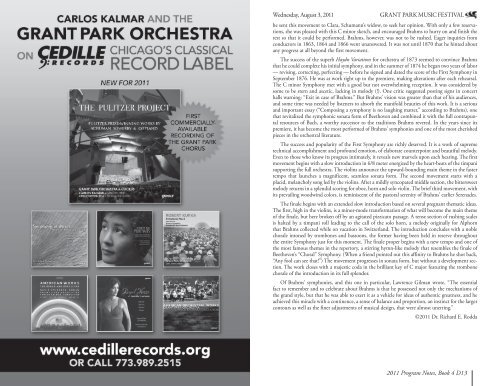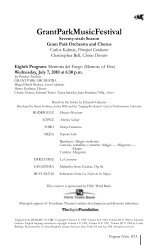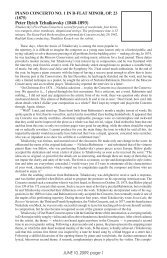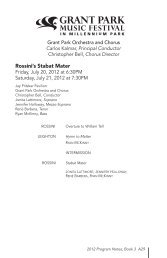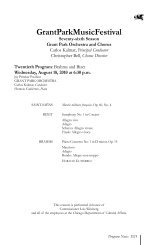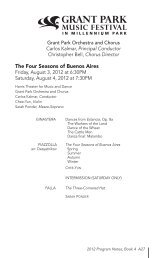Program Notes PDF - The Grant Park Music Festival
Program Notes PDF - The Grant Park Music Festival
Program Notes PDF - The Grant Park Music Festival
You also want an ePaper? Increase the reach of your titles
YUMPU automatically turns print PDFs into web optimized ePapers that Google loves.
Wednesday, August 3, 2011<br />
GRANT PARK MUSIC FESTIVAL<br />
he sent this movement to Clara, Schumann’s widow, to seek her opinion. With only a few reservations,<br />
she was pleased with this C minor sketch, and encouraged Brahms to hurry on and finish the<br />
rest so that it could be performed. Brahms, however, was not to be rushed. Eager inquiries from<br />
conductors in 1863, 1864 and 1866 went unanswered. It was not until 1870 that he hinted about<br />
any progress at all beyond the first movement.<br />
<strong>The</strong> success of the superb Haydn Variations for orchestra of 1873 seemed to convince Brahms<br />
that he could complete his initial symphony, and in the summer of 1874 he began two years of labor<br />
— revising, correcting, perfecting — before he signed and dated the score of the First Symphony in<br />
September 1876. He was at work right up to the premiere, making alterations after each rehearsal.<br />
<strong>The</strong> C minor Symphony met with a good but not overwhelming reception. It was considered by<br />
some to be stern and ascetic, lacking in melody (!). One critic suggested posting signs in concert<br />
halls warning: “Exit in case of Brahms.” But Brahms’ vision was greater than that of his audiences,<br />
and some time was needed by listeners to absorb the manifold beauties of this work. It is a serious<br />
and important essay (“Composing a symphony is no laughing matter,” according to Brahms), one<br />
that revitalized the symphonic sonata form of Beethoven and combined it with the full contrapuntal<br />
resources of Bach, a worthy successor to the traditions Brahms revered. In the years since its<br />
premiere, it has become the most performed of Brahms’ symphonies and one of the most cherished<br />
pieces in the orchestral literature.<br />
<strong>The</strong> success and popularity of the First Symphony are richly deserved. It is a work of supreme<br />
technical accomplishment and profound emotion, of elaborate counterpoint and beautiful melody.<br />
Even to those who know its progress intimately, it reveals new marvels upon each hearing. <strong>The</strong> first<br />
movement begins with a slow introduction in 6/8 meter energized by the heart-beats of the timpani<br />
supporting the full orchestra. <strong>The</strong> violins announce the upward-bounding main theme in the faster<br />
tempo that launches a magnificent, seamless sonata form. <strong>The</strong> second movement starts with a<br />
placid, melancholy song led by the violins. After a mildly syncopated middle section, the bittersweet<br />
melody returns in a splendid scoring for oboe, horn and solo violin. <strong>The</strong> brief third movement, with<br />
its prevailing woodwind colors, is reminiscent of the pastoral serenity of Brahms’ earlier Serenades.<br />
<strong>The</strong> finale begins with an extended slow introduction based on several pregnant thematic ideas.<br />
<strong>The</strong> first, high in the violins, is a minor-mode transformation of what will become the main theme<br />
of the finale, but here broken off by an agitated pizzicato passage. A tense section of rushing scales<br />
is halted by a timpani roll leading to the call of the solo horn, a melody originally for Alphorn<br />
that Brahms collected while on vacation in Switzerland. <strong>The</strong> introduction concludes with a noble<br />
chorale intoned by trombones and bassoons, the former having been held in reserve throughout<br />
the entire Symphony just for this moment. <strong>The</strong> finale proper begins with a new tempo and one of<br />
the most famous themes in the repertory, a stirring hymn-like melody that resembles the finale of<br />
Beethoven’s “Choral” Symphony. (When a friend pointed out this affinity to Brahms he shot back,<br />
“Any fool can see that!”) <strong>The</strong> movement progresses in sonata form, but without a development section.<br />
<strong>The</strong> work closes with a majestic coda in the brilliant key of C major featuring the trombone<br />
chorale of the introduction in its full splendor.<br />
Of Brahms’ symphonies, and this one in particular, Lawrence Gilman wrote, “<strong>The</strong> essential<br />
fact to remember and to celebrate about Brahms is that he possessed not only the mechanisms of<br />
the grand style, but that he was able to exert it as a vehicle for ideas of authentic greatness, and he<br />
achieved this miracle with a continence, a sense of balance and proportion, an instinct for the larger<br />
contours as well as the finer adjustments of musical design, that were almost unerring.”<br />
©2011 Dr. Richard E. Rodda<br />
2011 <strong>Program</strong> <strong>Notes</strong>, Book 4 D13


